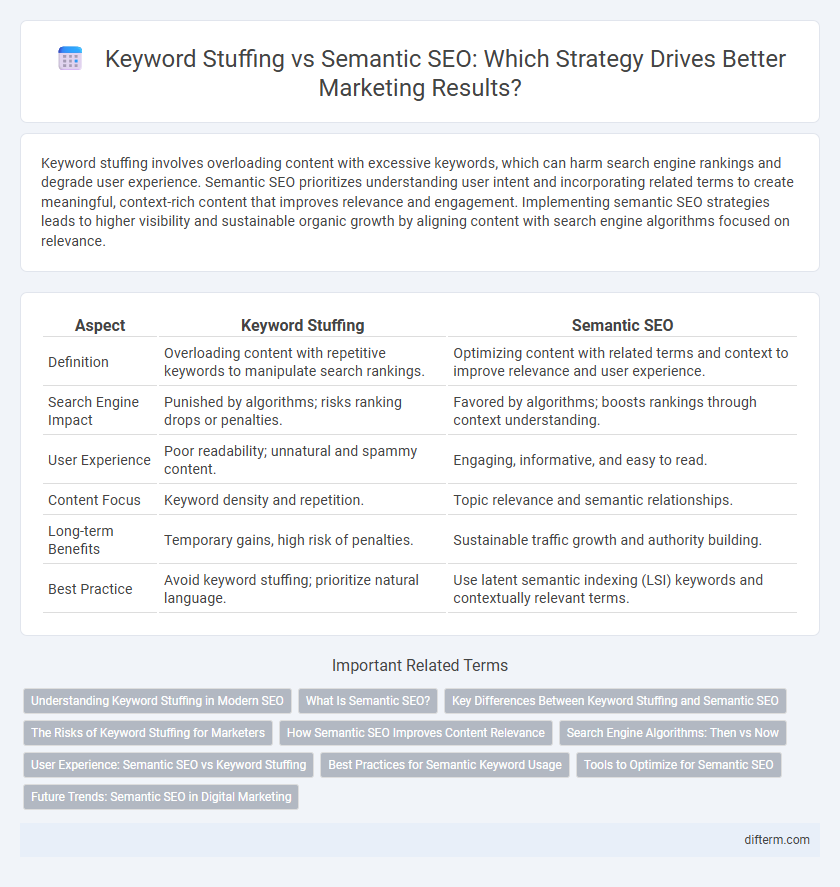Keyword stuffing involves overloading content with excessive keywords, which can harm search engine rankings and degrade user experience. Semantic SEO prioritizes understanding user intent and incorporating related terms to create meaningful, context-rich content that improves relevance and engagement. Implementing semantic SEO strategies leads to higher visibility and sustainable organic growth by aligning content with search engine algorithms focused on relevance.
Table of Comparison
| Aspect | Keyword Stuffing | Semantic SEO |
|---|---|---|
| Definition | Overloading content with repetitive keywords to manipulate search rankings. | Optimizing content with related terms and context to improve relevance and user experience. |
| Search Engine Impact | Punished by algorithms; risks ranking drops or penalties. | Favored by algorithms; boosts rankings through context understanding. |
| User Experience | Poor readability; unnatural and spammy content. | Engaging, informative, and easy to read. |
| Content Focus | Keyword density and repetition. | Topic relevance and semantic relationships. |
| Long-term Benefits | Temporary gains, high risk of penalties. | Sustainable traffic growth and authority building. |
| Best Practice | Avoid keyword stuffing; prioritize natural language. | Use latent semantic indexing (LSI) keywords and contextually relevant terms. |
Understanding Keyword Stuffing in Modern SEO
Keyword stuffing, the excessive use of target keywords in content, harms user experience and triggers search engine penalties in modern SEO practices. Search engines now prioritize semantic relevance and user intent, using natural language processing to interpret content context beyond mere keyword frequency. Effective SEO integrates a rich variety of related terms and meaningful phrases, ensuring content aligns with search intent while maintaining readability and authority.
What Is Semantic SEO?
Semantic SEO enhances website content by focusing on the meaning and context of keywords rather than merely repeating exact terms. It aims to improve search engine understanding through related concepts, synonyms, and user intent, resulting in more relevant and valuable content. This approach contrasts with keyword stuffing, which overloads pages with repetitive keywords and often leads to penalties from search engines.
Key Differences Between Keyword Stuffing and Semantic SEO
Keyword stuffing involves overloading web content with repetitive keywords to manipulate search engine rankings, often resulting in penalties and poor user experience. Semantic SEO focuses on understanding the intent behind search queries and creating contextually relevant content that satisfies user needs, enhancing both rankings and engagement. Key differences include keyword density versus contextual relevance, manipulative tactics versus user-centric strategies, and short-term gains versus sustainable organic growth.
The Risks of Keyword Stuffing for Marketers
Keyword stuffing poses significant risks for marketers, including search engine penalties, reduced website credibility, and poor user experience. Overloading content with repetitive keywords can lead to lower rankings on Google and other search engines, ultimately decreasing organic traffic and conversion rates. Semantic SEO, by contrast, enhances content relevance and engagement by focusing on contextually related terms and natural language, which improves both search visibility and audience trust.
How Semantic SEO Improves Content Relevance
Semantic SEO enhances content relevance by focusing on the meaning and context of keywords rather than mere repetition, leading to higher search engine rankings and improved user experience. It leverages latent semantic indexing and related terms to create comprehensive content that addresses user intent more effectively. This approach reduces keyword stuffing penalties while increasing organic traffic through more insightful and targeted information delivery.
Search Engine Algorithms: Then vs Now
Search engine algorithms initially favored keyword stuffing, prioritizing high keyword density to rank pages higher in search results. Modern algorithms use semantic SEO to understand context, user intent, and the relationship between terms, promoting content relevance over mere repetition. This shift rewards comprehensive, natural language content that aligns closely with searcher queries and improves user experience.
User Experience: Semantic SEO vs Keyword Stuffing
Keyword stuffing overwhelms users with repetitive, unnatural phrases, causing frustration and higher bounce rates, whereas semantic SEO enhances user experience by delivering contextually relevant content that aligns with search intent. Semantic SEO fosters better engagement through meaningful information and natural language, improving site credibility and dwell time. Prioritizing semantic techniques over keyword stuffing leads to a more satisfying and efficient user journey.
Best Practices for Semantic Keyword Usage
Effective semantic SEO emphasizes integrating contextually relevant keywords naturally within content to enhance search engine understanding and user experience. Avoid keyword stuffing, which involves overloading text with exact-match keywords, leading to penalties and lower rankings. Best practices include using latent semantic indexing (LSI) keywords, synonyms, and related phrases to create meaningful, authoritative content that aligns with user intent.
Tools to Optimize for Semantic SEO
Tools like SEMrush, Clearscope, and MarketMuse leverage Natural Language Processing to analyze content semantically, ensuring keyword relevance without overstuffing. These platforms identify related terms, search intent, and topic clusters to help marketers create comprehensive, user-focused content. Utilizing semantic SEO tools improves search engine rankings by enhancing content depth and contextual clarity.
Future Trends: Semantic SEO in Digital Marketing
Semantic SEO is poised to dominate future digital marketing strategies by prioritizing user intent and contextual relevance over mere keyword density. Advances in AI and natural language processing enable search engines to better understand content meaning, making keyword stuffing ineffective and potentially penalizing. Marketers who adopt semantic SEO approaches will achieve higher organic rankings and improved engagement by aligning content with evolving search algorithms and voice search trends.
Keyword Stuffing vs Semantic SEO Infographic

 difterm.com
difterm.com